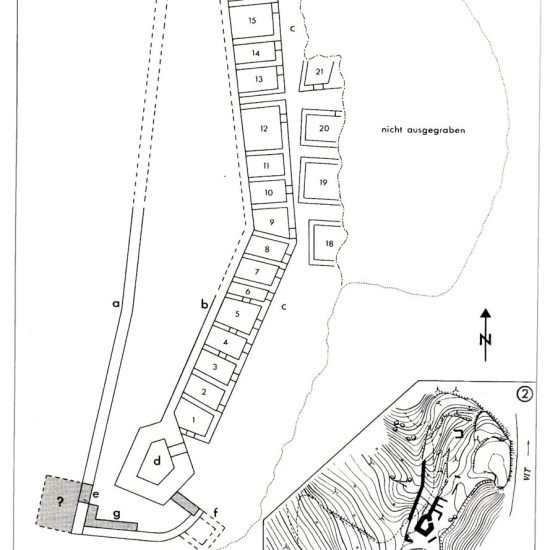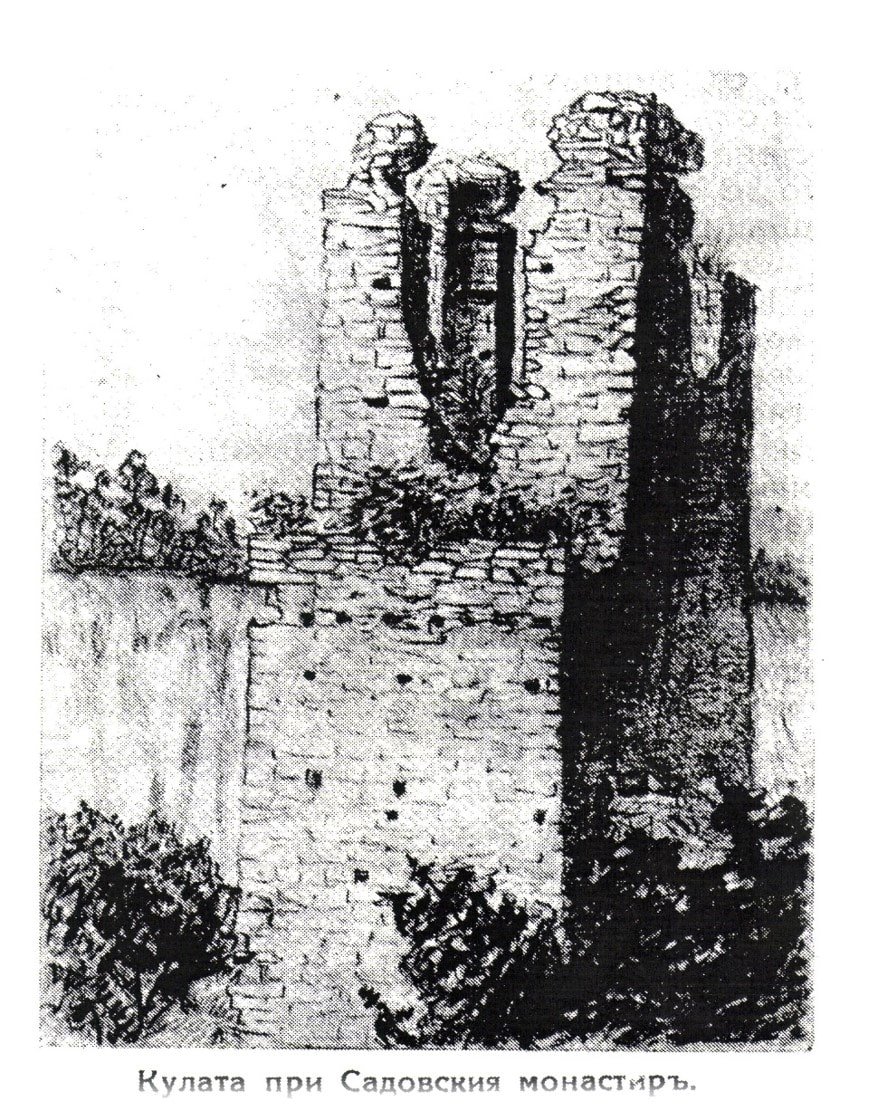Sadovec Fortresses
per person
The defense system of Byzantium on the Balkan Peninsula involved three main fortified lines: the Danube Limes, the Balkan Range and Strandzha Mountain. It was finally accomplished in the course of the 5th – 6th c. Fortresses great in number protected the area enclosed between the Danube River and the Balkan Range. For most part they followed the course of the rivers flowing there, Vit River including. The distances between the fortresses was usually 5 to 10 km as often two neighbouring ones enjoyed a direct visual connection. Many pairs of fortifications are now known set up on both sides of a river gorge – both fortresses by Sadovec are a rather informative example.
The inhabitants of these sites were engaged mainly in agriculture and stockbreeding oriented to the Byzantine big towns market. They were in most of the cases federates with military duties because of the constant Barbarian raids from the North and so peculiar of the time – the Great Migration Age.
Having in mind the rich data on Gothic colonization north of the Balkan Range coming from written sources, archaeological research, as well as from the analysis of the artefacts found in Sadovsko and Golemanovo Kale, and especially in the latter, most likely they were inhabited by Goths – federates. Their main income was agricultural products and military service along the Lower Danube Limes. For that they were paid in gold. Four hoards have been found there the golden coins prevailing. Many of the findings obviously produced by the metropolitan workshops also illustrate a luxury style – numerous expensive church or secular objects and jewels as a golden cross and a necklace composed of elements of gold, amethyst and lapis lazuli, a golden bracelet with garnet, bronze fibulae, a pair of silver spoons rather rare, various golden earrings and a massive golden belt buckle. Magnificent silver set includes a pair of fibulae and a belt buckle. Most probably both fibulae have been cast in the same mould. Unique is a pair of candlesticks forged from a silver sheet and with control stamps of Justinian’s age (527-565).
Among the federates in our case we have to mention the Goths. Their raids in today’s Bulgaria began about in the mid 3rd c. following one after the other. The opening decades of the 4th c. were overflowing with events. The relationship of the Goths and the Roman Empire developed. The raids abated a bit for the sake of colonization that began in northern Bulgaria on a large scale. In 348 a large group of Goths was forced to leave their villages north of the Danube River because of some religious controversies. Their leader was Bishop Wulfila. They were permitted to settle down in Moesia Secunda. The written sources mention Gothic colonies in the late 5th – early 6th c. as well. The colonization continued. Some records enlist Gothic soldiers in the Byzantine army in the 6th c. The Gothic tradition seems rather stable. In 1705 the map of Giullelme De l’Isle (= Lisle) (1675-1726) appeared under the title of Teatrum Historicum, covering the territories of the Eastern Roman Empire south and west of the Caspian Sea and the Black Sea. Somewhere in the middle of today’s Northern Bulgaria Gothi is marked, next to Moesia.
FORMAL ANALYSIS
In the summer of 1921 Ivan Velkov, curator of the Sofia National Museum and Vasil Mikov, then a student in history, began a field survey along the valley of Vit River in Northern Bulgaria. The area lied quite away from the busy roads and cultural centres, and the ancient writers as well as the then contemporary scholars knew it rather vaguely.
The Vit valley altogether with its feeders of Chernelka, Tuchenitsa and Kamenitsa, was rich in dense woods, tiny well-fed fields and caves thus providing the most friendly environment for life in peace or shelter in days of trouble for all times.
As a result of the survey, Ivan Velkov issued some topographic maps, drawings and sketches, and descriptions of sites and artefacts. The description of the ruins by Sadovec village – Sadovsko Kale, Golemanovo Kale (Kale is the Turkish word for fortress) and Sadovec Monastery (12th c.) appeared also for the first time. In 1934, Ivan Velkov led the first archaeological research of Sadovsko Kale. The results were brilliant. In April 1935 he released them in Germania Magazine. Even then, he associated the villages – fortresses with the Goths. Todor Gerassimov worked out and issued the numerous coins, two 6th century golden coin hoards included. The excavations continued in 1936 at the opposite Golemanovo Kale, now as a co-project of the Bulgarian and German Archaeological Institutes. The team leader was Gerhard Bersu. The excavations were over in 1937. The Second World War and the most complicated age that followed delayed for ten of years the release of the results. The detailed publication of the data on Sadovec appeared in 1992 in German as a work of the most prominent Bulgarian and German scholars.
Sadovsko Kale and Golemanovo Kale make a pair of fortresses rising opposite one another on both sides of Vit River. In the late 3rd till the late 4th c. a village existed at the site of Golemanovo Kale. Its inhabitants were likely artisans and ironsmiths as a lot of iron slag and some kilns were revealed there. The village was burnt down by the Goth’s invasion before the battle at Hadrianopolis in 378 or possibly by the Huns. During the 5th c. the site was abandoned. The fortress was constructed in the mid 6th c. under Emperor Justinian. It was set up over a naturally protected site on the right bank of the river. The fortress walls were of a solid construction taking advantage of the terrain. The northern walls were doubled, and pairs of towers rose to the west.
The houses followed the peculiarities of the terrain. They were arranged in tiers. The foundations were laid in stone, and the upper floors were perhaps of wood. When the fortress was burnt down, all that remained was a thick layer of ash. Small narrow streets run between the houses forming a kind of situlae various in size.
In the 6th c. another open village also existed to the west of the fortress. At its site one-nave basilica was set up that perished in fire about 560.
Sadovsko Kale rises at a site peculiar of its time. It is on the left bank of Vit River, 2 km east of Sadovec village. Sheer rocks naturally protect its northern and eastern sides, and a fortress walls run along its other two peripheries. The built-up area measures 80 m in length and 20 m in width. The main sector of the fortress runs along the western periphery of the hill. The wall is also doubled. To the south both walls form a space pentagon in shape and well protected. This room is rather interesting because of the artifacts found inside. Most probably it was a workshop. A fireplace dug into the ground was revealed, and also bronze tubes employed to blow glassware. Seventeen houses were investigated inside the fortress. They were arranged along the inner wall, all their entrances facing east. Opposite them and divided by a narrow street four more constructions were revealed. Again, the foundations were laid in stone with upper floors made of wood. The artefacts discovered are really rich: various jewels, fibulae, numerous fragments of glassware and window glass.
Both Golemanovo and Sadovsko Kale perished in fire about the very late 6th c. The written sources record that in 597 a severe Avar invasion swept away many fortresses in today’s Northern Bulgaria. The coin hoards found in Golemanovo Kale and in other fortresses in the region support this information – the latest coins within them belong to Emperor Mauritius dating from 595 – 596.
KATYA MELAMED
- Map of Golemanovo Kale (1), Sadovsko Kale (2) and Sadovec Monastery (3). (Uenze 1992, p. 25) © PLANS AND DRAWINGS, UENZE, 1992
- Drawing of the 12th c. Monastery © DRAWINGS, UENZE, 1992
- Plan of Sadovsko Kale © Uenze 1992
- Map of Golemanovo Kale with the location of the church extra muros © Uenze 1992
- Plan of Golemanovo Kale © Uenze 1992
- Plan of the church extra muros – Golemanovo Kale © Uenze 1992
- Candlesticks © FOTS. KRASSIMIR GEORGIEV
- Candlesticks. A drawing © Uenze 1992
- A pair of silver spoons © FOTS. KRASSIMIR GEORGIEV
- Pectoral cross – encolpion, gold, filigree, amethyst © FOTS. KRASSIMIR GEORGIEV
- Pectoral cross – encolpion, gold, likely from Sadovec © FOTS. KRASSIMIR GEORGIEV
- Back side of the cross; inscription in Greek Light – Life (ΦΩC ΖΩΗ) © FOTS. KRASSIMIR GEORGIEV
Tour Location
Sadovec Fortresses
| Other monuments and places to visit | Regional History Museum of Pleven |
| Natural Heritage | |
| Historical Recreations | |
| Festivals of Tourist Interest | |
| Fairs | |
| Tourist Office | tourpleven@abv.bg |
| Specialized Guides | In the Museum - yes |
| Guided visits | In the Museum - yes |
| Accommodations | Plenty of in Pleven |
| Restaurants | Plenty of in Pleven |
| Craft | |
| Bibliography | |
| Videos | |
| Website | visitpleven.com |
| Monument or place to visit | The ruins of Sadovec are not socialized. The artefacts found are housed in the National Archaeological Institute with Museum in Sofia. On display in the Museum are the jewels and the silver candlesticks. The rest of the finds are kept in the Museum depot after restoration in Germany. |
| Style | Provincial Byzantine architecture. |
| Type | Architectural remains of fortresses, houses and churches from the 6th – early 7th c. |
| Epoch | 6th – early 7th c. |
| State of conservation | Partial conservation and no socialization. |
| Degree of legal protection | Regional Historical Museum - Pleven |
| Mailing address | museum@rim-pleven.com |
| Coordinates GPS | Golemanovo Kale N 43017ʹ32ʺ E 24022ʹ40ʺ Altitude 159 m Sadovsko Kale N 43017ʹ16ʺ E 24022ʹ47ʺ Altitude 153 m |
| Property, dependency | Monument of culture of national significance; Ministry of Culture – Republic of Bulgaria |
| Possibility of visits by the general public or only specialists | |
| Conservation needs | Yes |
| Visiting hours and conditions | |
| Ticket amount | Free access |
| Research work in progress | |
| Accessibility | Difficult |
| Signaling if it is registered on the route | |
| Bibliography | Иванов, Р. Долнодунавският лимес в карти от XV – XVIII век. – Археология 2, 1994, 5-18, Fig. 7. Bersu, G. A 6th Century German Settlement of Foederati. Golemanovo Kale Near Sadovetz, Bulgaria. – Antiquity XII, 1938, 31-43. Uenze, S. Die Spätantiken Befestigungen von Sadovec (Bulgarien). Ergebnisse der Deutsch – Bulgarisch – Österreichischen Ausgrabungen 1934 – 1937. München: C. H. Beck’sche Verlagsbuchhandlung 1992. Welkov, I. Eine Gotenfestung bei Sadovetz (Nordbulgarien). – Germania 19, April 1935, Heft 2, 149-158 (The works of both G. Bersu and I. Velkov are also included in the volume of S. Uenze, Die Spätantiken Befestigungen…). |
| Videos | |
| Information websites | TripadvisorSadovsko Kale Golemanovo Kale |
| Location | Sadovsko Kale – 3.2 km SE of Sadovets village; Golemanovo Kale – 2.7 km SE of Sadovets village; Sadovets village – 29 km away from the main town of Pleven |



























